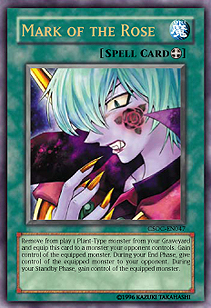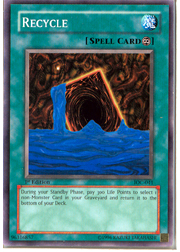 Hey, it’s Friday! Everyone knows that that means! It means it’s time to sit through another lecture about tournament behavior! (I know you were pining for this.) Anyway, this week I would like to talk to you about marked cards. Marked cards seem very straightforward as a concept — there is a noun we all recognize (cards) and a clear adjective (marked). Marked cards. You’d think the phrase would explain itself, but I’ve actually found there to be a fair bit of confusion about what actually constitutes a "marked card," which makes it a perfect topic to tackle today.
Hey, it’s Friday! Everyone knows that that means! It means it’s time to sit through another lecture about tournament behavior! (I know you were pining for this.) Anyway, this week I would like to talk to you about marked cards. Marked cards seem very straightforward as a concept — there is a noun we all recognize (cards) and a clear adjective (marked). Marked cards. You’d think the phrase would explain itself, but I’ve actually found there to be a fair bit of confusion about what actually constitutes a "marked card," which makes it a perfect topic to tackle today.
Now then, there are usually two main sources of confusion — one arises from the word "marked," and the other from the word "card." Let’s start with "marked" and you’ll see what I mean.
A "marked" card is a card that is different from other cards in the deck. I’ve had conversations with players who use the term "marked" cards to specifically designate cards that have been deliberately altered for the purposes of cheating — and they fully believe that a card cannot be marked unintentionally. If a player thinks a card isn’t marked if that duelist didn’t mark it on purpose, or isn’t paying attention to existing markings, that player might end up getting a penalty that can knock his or her tournament record on the head.
Let’s be very specific — a "marked" card is a card that is different from the other cards in your deck. It could be a physical mark on the card, which has been either added to the card or is an inherent flaw in production (such as an ink irregularity or a roller mark). These are the markings that most players think of first.
But you cannot overlook the physical condition of the card when you’re evaluating whether or not it is marked. The physical state of a card often varies from the other cards in a deck. These variations can be a bend or curve, as is often seen with some foils in humid environments. It can be a card that is excessively worn or creased, or irregularly cut. It could be a card with a different thickness, texture, or "feel" than other cards. If there is a difference, the card is marked.
"What about signed cards?" This could be your next logical question, so let’s further clarify "marked." Lots of players do like to use signed cards, or cards with altered artwork — the general rule is "If the card can be differentiated from other cards in your deck while looking at the back or the sides, it is marked." Players should not be looking at the fronts of their cards when shuffling, etc. (if they are, that’s a whole different article) so the front is not the problem. As long as the card is identical to the rest of your cards from the back and sides, it is not considered marked. (Please bear in mind that physical differences such as a bends, card texture, creases etc. can make a card recognizable from the back.)
I think we’ve covered "marked," so let’s tackle "card." If you are using sleeves, the sleeves are treated as part of your card. There isn’t a separate category of tournament penalties for "marked sleeves." So, if any of your sleeves can be distinguished from any of the other sleeves in your deck from the back or sides, they are considered marked, and marked card penalties will apply.
Players sometimes think that as long as they aren’t using marked cards to cheat, they will not get a penalty — they’ll just explain to the judge that the cards are old, or were like that before, that the sleeves came out of the package with flaws, or they didn’t really notice that there were any markings, and the judge will say, "OK, that’s fine," and that will be the end of it. This just isn’t the case.
Remember that the Marked Cards — Minor penalty (warning) or Marked Cards — Major penalty (match loss) is given out for unintentional infractions. If a judge is giving you one of these marked card penalties, they already assume you are not trying to cheat. If your cards are marked, receiving a penalty for having marked cards is the appropriate course of action.
Now — players are responsible for the condition of their cards and sleeves. This is stated in the Tournament Policy. If a player takes marked cards to an event, that player runs the risk of getting a penalty — this isn’t a way to discriminate against players who may have cards in less than perfect condition, or who don’t want to buy new sleeves. The policy is in place to help keep the event as fair as possible for the general tournament population. Obviously, players need to do their part to make sure their cards are not marked. It is not the responsibility of the judges to catch any markings and point them out to you before the tournament. It is not the responsibility of your teammate to remind you that he or she noticed the Sangan you used last time was fraying in the corner, so you’d better make sure you didn’t put it in your deck. It is not the responsibility of the card or sleeve manufacturer to send out a product guaranteed absolutely 100% perfect that requires no examination from the consumer. As stated in tournament policy, it is the responsibility of the player.
Avoid using marked cards!
OK, it’s ultimately up to you, the player. You spend time and thought to put your deck together before the event, so take it a step further and make sure you carefully examine your cards as you put the deck together. I imagine you’ve behaved tenderly toward that Dark Armed Dragon, but perhaps you have treated that Structure Deck Heavy Storm with unnecessary roughness? Pay particular attention to your older cards and "deck staples" as they tend to show wear earlier.
 Look at the cards. Are they all in clean, crease-free, bend-free condition? Check your sleeves. Are they all the same color, size, without any scratches or defects, and in clean condition? If you find a card or sleeve that is different, don’t put it in your deck.
Look at the cards. Are they all in clean, crease-free, bend-free condition? Check your sleeves. Are they all the same color, size, without any scratches or defects, and in clean condition? If you find a card or sleeve that is different, don’t put it in your deck.
Take the time to look over your cards and sleeves between rounds. Sleeves in particular can become dirty, scratched, or split. Cards that had a mild crease can become more creased; cards that had a bend can become more bent. Make sure your cards are all aligned the same way (having cards turned upside down in your deck makes them distinguishable from the other cards), and that the tops of the cards are all pushed completely down in the sleeves. Bring extra sleeves to replace any that are damaged.
This is important — when you are trading or buying singles, make sure you really look at the cards. Carefully examine the back and all the sides. Have the cards been marked or altered in any way? Are the corners weak or flexible? Is there dirt or any substance you can feel on the surface of the card? If you are buying through the mail or online, it’s not always possible to examine the actual card so ask the current owner these very specific questions, and buy or trade accordingly. I have participated in marked card investigations before for players who have been penalized for cards they purchased or traded for, and then put in their decks without careful examination. Knowing that you paid good money or traded away good cards in exchange for cards that got you a marked card penalty (or worst case, a DQ) would be the very bitter frosting on a cake made of sadness — please don’t put yourself in the position of having to eat that kind of cake. It tastes bad.
Hopefully, more of you have an improved understanding of what is (and isn’t) a marked card, how the penalties work, and most importantly how to avoid putting marked cards in your decks. You might not know it from reading tournament reports from unhappy players, but judges don’t generally enjoy having to give out penalties — we’d much rather have an informed, responsible player base that does its part to make sure these kinds of things don’t have to happen. If you aren’t already examining your cards and sleeves before an event, start now. If you make less-than-detailed examinations of cards before buying and trading, stop now. Find a brand of sleeves that is consistent and holds up well, and make sure you always have some on hand.
And best of luck at your next event! Make me proud.